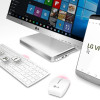Review: LG V10 for AT&T
Nov 20, 2015, 4:00 PM by Eric M. Zeman

The V10 from LG includes a secondary display and advanced camera features. This massive Android smartphone is a flagship-class device thanks to good specs, solid build quality, and decent all-around performance. In Phone Scoop's full report we assess the usefulness of the second screen. Read on for our verdict.
Is It Your Type?
The LG V10 is a large, semi-rugged flagship smartphone, but also a bit of an oddball thanks to its extra, secondary display. This makes it perfect for those seeking something off the beaten path. Beyond the second screen, the V10 also packs powerful camera technology, which should appeal to shutterbugs, and a fingerprint reader for fans of biometrics. The V10 is therefore a curiosity for people who want a high-end LG handset with all the bells and whistles.
Body
The V10 is yet another variation on a theme from LG. It takes the basic design of the G4 and applies some tweaks in order to give the V10 a more unique look and feature set. There are several core elements that define the V10 and help it stand apart from its stablemates. To start, it has a second screen on the front, used to display notifications. It also adds metal to the frame, and more rugged plastics.
The majority of phones LG has released this year share the same silhouette. This is no exception. I'm not saying it's good or bad; it simply is.
The V10 makes use of this DNA, but shows signs of evolution. For example, the V10 has a mostly flat rear surface, which helps it sit in a stable way on flat surfaces like tables or desks. (The G4, in comparison, has a curved rear surface and wobbles all over the place.) The V10 has stainless steel rails along the side edges, which give it strength and a nice upgrade in looks. (Metal has been absent from LG phones for far too long.) It also moves away from the flimsy rear plastic materials in favor of a much sturdier and appealing polycarbonate rear shell. The phone is more chaotic looking than the svelte G4, but I count that as a positive in this case. If you want something less wild, there are plenty of options; the V10 is LG untamed.
There's no getting around the V10's size; it's a phablet through and through. The thick profile, metal elements, and massive battery mean it's a heavy sucker, too. I often needed two hands to use the phone without fear of dropping it. The downside of the flatter rear surface? The V10 won't sit as deeply in your palm. If you have small hands, it simply may not work. The same goes if you have tight jeans. The size and materials may make it somewhat difficult to jam into your pocket. The weight means you can always feel it, no matter where you choose to stow it.
The front surface of the phone is less cohesive than past LG handsets, but that's fine as far as I am concerned. Black glass consumes the bulk of the face. It's contained within chrome-colored rails on the sides. The bezel above and below the display matches the phone's color (white, black, blue, or greenish). The earpiece speaker is covered with a chrome grill, and a sensor is positioned next to it. There are no buttons below the display, but the two user-facing cameras and Second Screen are plainly visible at the top of the glass.
LG's habit of putting buttons on the back of its phones means the metal rails are solid and uninterrupted strips defining the V10's girth. I like the smooth feeling of the metal against. The V10 is comfortable when gripped tightly.
All of the buttons and controls are found on the rear surface. The V10 has a revised version of this trio of keys. LG has long split the volume controls in two, with the screen lock / power button in the middle. The volume toggles are indented, while the screen lock button is somewhat raised. On the V10, the screen lock button is now a fingerprint sensor. It's circular and rimmed in chrome that gives it a more distinct profile than on other LG handsets. All three buttons have good travel and feedback, but if you're not used to their placement (on the rear) they may take some getting used to.

The camera module is round, raised, and about the size of a quarter. It has a shiny, ribbed texture that sets it apart visually from the matte rear shell. There is no dedicated camera button. The bottom of the phone houses the headphone jack, micro USB port, and speaker.
The rear cover peels off easily. LG has kept several beloved — but increasingly rare — features: a removable battery and a memory card slot. The memory card slot is stacked with the SIM card. You have to remove the battery to pull out the SIM, but there's just enough room swap the memory card without pulling the battery.
Surprisingly, the V10 is sort of rugged. It's not going to survive a tumble down some concrete steps, but you can drop it here and there and not worry too much about it breaking.
The V10 won't appeal to everyone, but I find it a welcome break from boring, staid designs.
Screen
The main display measures 5.7 inches and contains 2,560 by 1,440 pixels (which is quad HD resolution, the current gold standard.) LG used an in-plane switching (IPS) LCD panel and it looks phenomenal. Even at this large physical size, elements on the screen are incredibly sharp; you won't see any individual pixels anywhere. Colors are accurate and viewing angles are pretty good, too. With brightness set high, the screen was usable outdoors even under direct sunlight. It's truly a fine display.
The second screen is a narrow 2.1 inches across with 1,040 by 160 pixels. I had a harder time seeing it outdoors, but it's bright enough for easy use indoors. The resolution is fine for such a small display and the small icons and text it displayed looked clean and sharp.

Signal
I tested the AT&T version of the LG V10 and it performed admirably in and around New York City. The phone remained connected to LTE most of the time, but I saw it dip to HSPA a handful of times in poor coverage areas. The phone always connected calls on the first attempt, and did not drop any, even at highway speeds. Data speeds were great when under a strong signal. The V10 performs on par with other phones on AT&T's network, which is what we like to see.
Sound
The V10 is an excellent voice phone. I was impressed by the clarity of voice calls. The earpiece produces loud and clear conversations. It often sounded like the person with whom I was speaking was standing in the same room. Volume is more than adequate for most environments, save for standing next to a jet engine. In fact, you can set the volume at about 60% most of the time. People I spoke to said I sounded very good. The V10 outperforms most other handsets I've tested on AT&T's network lately.
The speakerphone isn't so great. It delivers plenty of volume, but voices sound as if they are coming through a sock. Moreover, if you set the volume all the way up, the quality degrades further with distortion and boominess.
If you set the volume up all the way, ringers and alerts will wake you from the deepest of slumbers. The vibrate alert is just OK.
Battery
The V10 has a 3,000 mAh battery. The phone supports QuickCharge 2.0, which means it can power up in a hurry. It can go from 0% to 100% in less than two hours, which is truly useful.
Part of the point of the second screen is to help save battery power. I can't say it had any measurable impact. I got a day out of the V10 no matter how much I tried to use the second screen instead of the main screen. The phone easily delivered a full waking day of power; it lasted from breakfast to bedtime consistently with some power to spare.
LG gave the phone several tools to help manage battery life. To start, it has power saver mode, which kicks on when the battery reaches 15%. When turned on, this automatically dims the screen more aggressively, reduces processor output, and cancels vibrate alerts. The V10 also has a setting that specifically reduces the processor power given to games. Thanks to decent battery life, I didn't need these tools while I reviewed the phone.
Bluetooth, GPS, NFC, WiFi
The V10's radios all functioned properly. Bluetooth was a cinch to use and the NFC helped me pair the V10 with a handful of Bluetooth accessories. I used the V10 for a few calls via my car's hands-free system and calls sounded very good. Music was pleasant when passed through a good set of headphones.
Google Maps and the V10's GPS radio interacted with one another perfectly. The phone located me swiftly and was accurate to about 15 feet. I especially enjoyed watching the blue dot move as I walked the streets of Manhattan.
The WiFi worked just fine.


















 Hands On with the LG V10
Hands On with the LG V10
 LG V10 Boasts Second Screen, Dual Front Cameras
LG V10 Boasts Second Screen, Dual Front Cameras
 LG Announces the V20 With Android 7, Second Screen, and Dual Cameras
LG Announces the V20 With Android 7, Second Screen, and Dual Cameras
 LG's VPInput App Lets PCs Control Smartphones Via Bluetooth
LG's VPInput App Lets PCs Control Smartphones Via Bluetooth
 AT&T, T-Mobile Reveal LG V10 Launch Plans
AT&T, T-Mobile Reveal LG V10 Launch Plans
 LG V10 (GSM)
LG V10 (GSM)




